- Home
- »
- Reports
- »
-
Vitamins & Dietary Supplements Cost Intelligence Report, 2030
![Vitamins & Dietary Supplements Cost Intelligence Report, 2030]()
Vitamins & Dietary Supplements Procurement Intelligence Report, 2023 - 2030 (Revenue Forecast, Supplier Ranking & Matrix, Emerging Technologies, Pricing Models, Cost Structure, Engagement & Operating Model, Competitive Landscape)
- Published Date: Jan, 2024
- Base Year for Estimate: 2022
- Report ID: GVR-P-10505
- Format: Electronic (PDF)
- Historical Data: 2020 - 2021
- Number of Pages: 60
Vitamins & Dietary Supplements Category Overview
“Rising focus on preventive healthcare, a surge in demand for immunity boosting products post the COVID-19 pandemic, and awareness of personalized nutrition are fueling the category’s growth.”
The global vitamins & dietary supplements category is anticipated to grow at a CAGR of 8.5% from 2023 to 2030. This growth can be attributed to factors such as the rising focus on preventive healthcare, and personalized nutrition, an increase in geriatric population, and a surge in demand for immunity-boosting products post the COVID-19 pandemic. A few of the key challenges faced by the category are an increased need for governmental intervention, threat of counterfeit supplements, and distrust of consumers regarding safety and effectiveness.
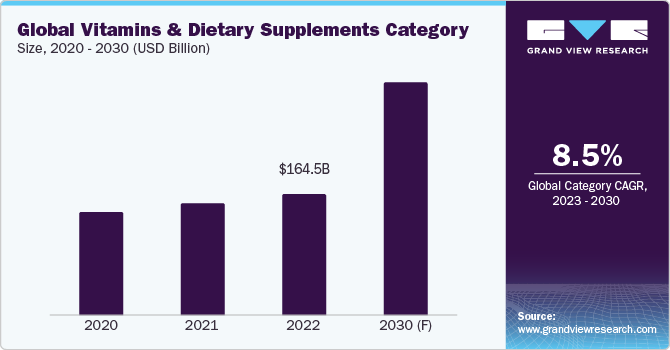
Vitamins & dietary supplements have end-use applications in pharmaceuticals, nutraceuticals, feed products, foods and beverages, and personal care products. These products contain dietary ingredients that are required to supplement the diet, such as vitamin subtypes (e.g., A, B, C, D, E, and K), minerals, amino acids, enzymes, and probiotics. For instance, Vitamin A supplements may be added to animal diets to ensure adequate supply, especially when livestock lack good pasture and green forages. Similarly, Vitamin D may be added to animal foods to prevent nutritional deficiencies that lead to diseases such as rickets.
The global vitamins & dietary supplements category was valued at USD 164.5 billion in 2022. The demand for immunity-boosting products has increased significantly after the pandemic, which has contributed to the size and growth of this category. Accessibility of these products has improved due to rise in marketing and presence of a variety of distribution channels. These factors are expected to continue fueling this market’s growth during the forecasted period. Moreover, in the past few years, there has been a rise in demand for organic, herbal, vegan, and vegetarian products in this category due to the growing popularity of veganism and awareness of the benefits of natural ingredients.
The key technologies driving the growth of this category include nanoencapsulation, biohacking and targeted supplementation, nutrigenomics, 3D printing of capsules, and time-released delivery. Nanoencapsulation offers several benefits such as improving the stability and solubility of bioactive compounds used for manufacturing vitamins and dietary supplements. It also prevents deterioration of products during storage and transportation. This technology also enhances the bioavailability and potency of target compounds in the products. Biohacking and targeted supplementation are used to offer targeted and personalized nutritional support according to individual biological makeup.
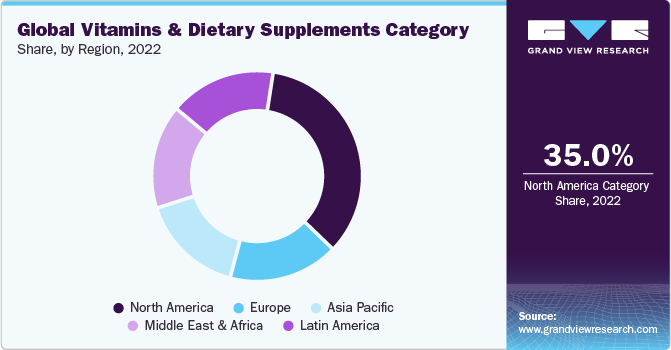
North America dominates the global category, accounting for 35% of the market share. This growth is attributed to a surge in demand for specific types of products such as probiotic supplements, fish oils, and protein supplements, prevalence of lifestyle diseases, and awareness of the health benefits of dietary supplements. Europe accounts for the second largest market share, owing to increased attention to health by consumers, awareness of the significance of vitamins and dietary supplements in supporting weight control and physical activity, and consumer readiness to pursue a healthier lifestyle. Asia Pacific is anticipated to witness the fastest growth rate during the forecast timeframe.
The vitamins & dietary supplement manufacturing processes are increasingly being outsourced to third-party entities such as contract development & manufacturing organizations (CDMOs). Some of the key benefits (which are also the driving factors) of contract manufacturing include reduced operational and overhead costs, improvement in operational efficiency, availability of advanced technologies, and better alternatives related to shipping and logistics. Contract manufacturing leads to expertise in formulation development, navigating regulatory compliance, scalability, and flexibility. For instance, some contract manufacturers have dedicated capabilities in preparing dietary supplements with distinct health benefits that can be used for providing personalized nutrition.
Supplier Intelligence
“What best describes the nature of the Vitamins & Dietary Supplements category? Who are some of the main participants?”
The global vitamins & dietary supplements category is fragmented, exhibiting intense competition among the industry players. Key companies compete based on pricing strategies, product innovations, packaging, labeling, and advertising and emphasize product quality, innovation, and cost-effectiveness. Theyfocus on implementing strategic initiatives to reinforce their market position, due to the competitive environment and changing customer demand. In addition, the players establish strategic partnerships and collaborations to enhance their geographic presence and product portfolio. A few players are also actively expanding their global footprint by setting up local distributors or purchasing subsidiaries in new regions.
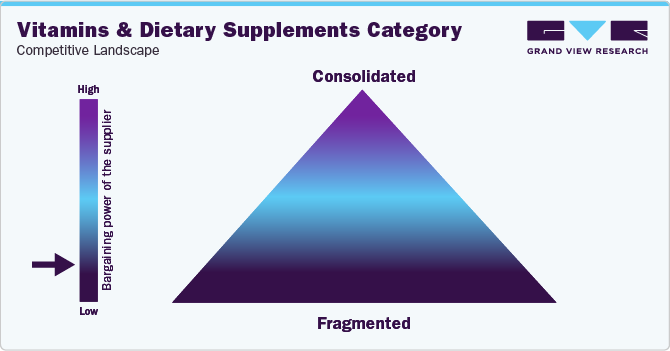
Buyers in this category possess high negotiating capability, enabling them with the flexibility to switch to a better alternative. Customers can be quite selective as they aim to purchase the best available options at the lowest feasible cost. This increases pressure on the suppliers in terms of pricing and product quality. Besides, regulatory laws in several countries require companies to have stringent quality control and safety standards. Customers are likely to look for lucrative offers and discounts on product pricing, and distribution channels intensely compete based on price discounts and offers. For instance, distribution channels may offer discounted bundled pricing when customers purchase a bunch of products as part of a package.
Key suppliers covered in the category:
-
Abbott Laboratories
-
Amway Corporation
-
Archer Daniels Midland Company (ADM)
-
BASF SE
-
Bayer AG
-
DSM Nutritional Products AG
-
GSK plc
-
Herbalife International, Inc.
-
Lonza Group Limited
-
Pfizer, Inc.
Pricing and Cost Intelligence
“What is the cost structure for Vitamins & Dietary Supplements? What variables affect the prices?”
The cost structure of the global vitamins & dietary supplements category is constituted by raw materials, labor, technology & equipment, energy & utilities, packaging, labeling, and logistics, and other costs as the key components. Other costs are further divided into R&D, regulatory & compliance, rent, general & administrative, sales & marketing, and finance & taxes. Raw materials and ingredients constitute the major chunk of the cost structure.
The prices of products offered in the category are influenced by several variables. Key factors affecting the prices include raw material sourcing, energy price fluctuations, challenges in storage and logistics, packaging and labeling requirements, costs of compliance and quality control, competition among manufacturers, challenges in distribution, and inflation. For instance, key players may be required to source raw materials and active ingredients from several countries. In this case, supply chain disturbances may lead to an upsurge in raw material prices and result in sourcing challenges. Energy price fluctuations include changes in prices of commodities such as coal, crude oil, and natural gas, which directly affect the cost of electricity. Such fluctuations lead to an upsurge in the pricing of finished products.
Key raw materials used for product manufacturing in this category include several types of active ingredients used in vitamin supplements such as retinol, retinyl esters, carotenoids (e.g., alpha-carotene, beta-carotene), thiamin, riboflavin, niacin, pantothenic acid, pyridoxine, biotin, folic acid, methycobalamin / cyanocobalamin, ascorbic acid, cholecalciferol, and alpha-tocopherol acetate. Other raw materials include active ingredients used in mineral supplements such as calcium carbonate, magnesium aspartate, cupric oxide, sodium fluoride, and zinc sulfate. The raw materials also include inactive ingredients (also known as excipients) such as binding agents (e.g., cellulose, magnesium stearate), coating agents, coloring agents, diluting agents, fillers, emulsifiers, flavoring agents, and disintegrants.
The prices of active ingredients and excipients witnessed significant fluctuations in 2022 and 2023 due to supply-demand imbalances, geopolitical conflicts, and high inflation. For instance, the prices of ascorbic acid (used in vitamin C supplements) in the U.S. declined during the third quarter of 2023, due to a substantial drop in demand and significant availability of supply during this period. The Cost and Freight (CFR) values of ascorbic acid declined from USD 3700 - USD 3800 per metric ton (mt) in July to USD 3400 - USD 3500 per mt in September.
The cost structure is broken down in the accompanying chart. Other costs can depend on multiple cost components as illustrated below:
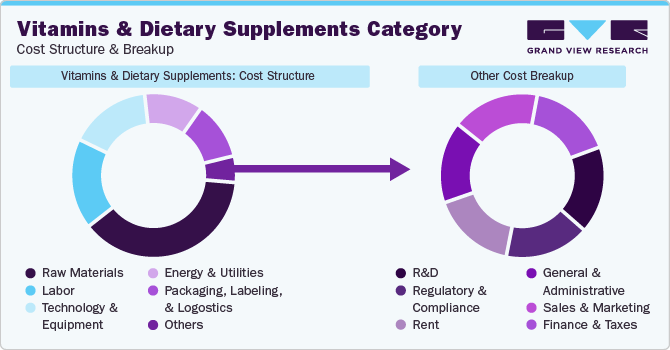
The report provides a detailed analysis of the cost structure and the pricing models adopted by prominent suppliers in this category.
Sourcing Intelligence
“How do Vitamins & Dietary Supplements manufacturers engage? What is the type of engagement model?”
In terms of global vitamins & dietary supplements category sourcing intelligence, businesses commonly follow a hybrid/bundled outsourcing model to engage with their suppliers. In the hybrid/bundled outsourcing model, the clients outsource certain parts of the overall manufacturing operations to third parties. Generally, the client conducts critical operations in-house. However, in certain scenarios, businesses may adopt a full-service outsourcing model wherein end-to-end manufacturing is outsourced to third-party contract manufacturers such as CDMOs.
In some instances, processes such as packaging, labeling, storage, and transportation may be outsourced as the manufacturer may not possess the required capability in-house. Such processes may also be outsourced to attain cost savings and streamline operations. The flexibility and scalability of the hybrid model enable manufacturers to minimize their requirement for additional/specialist workforce to conduct those activities that can be outsourced. It helps them to minimize their operational cost and increase focus on their core activities.
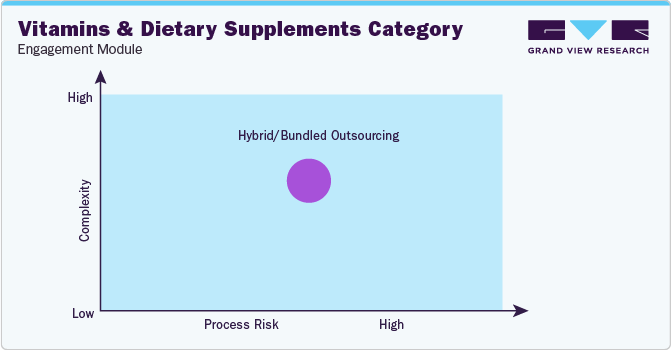
“In the hybrid outsourcing model, the client outsources some parts of the overall operation to third parties. Generally, critical operations are carried out in-house by the client.”
Consumers consider certain factors when purchasing vitamins & dietary supplements. The key factors include pricing, safety, end-use / application, and product innovations. The product ingredients (e.g., organic or chemical-based) and brand reputation are also considered. Moreover, buyers also check for regulatory certifications that assure product compliance with quality and safety standards. From the supply side, manufacturers prefer to sign long-term contracts with raw material suppliers for increased stability, security, dedicated support, and strengthening of partnerships. However, in some instances, manufacturers may opt for medium-term or short-term contracts with suppliers for ad-hoc requirements.
India is the preferred low-cost/best-cost country for sourcing vitamins & dietary supplements. A growing number of international companies have entered the Indian market, leading to increased industry competition, competitive pricing, and a rise in innovation. Moreover, leading domestic companies are also competing with the international players. Rising R&D investments by the private sector and improvement in quality control standards by the Food Safety and Standards Authority of India (FSSAI) have fueled the growth of the vitamins and dietary supplements category in India in the recent past. The same trend is expected to continue during the next few years.
The report also provides details regarding day one, quick wins, portfolio analysis, key negotiation strategies of key suppliers, and low-cost/best-cost sourcing analysis.
Vitamins & Dietary Supplements Category Procurement Intelligence Report Scope
Report Attribute
Details
Vitamins & Dietary Supplements Category Growth Rate
CAGR of 8.5% from 2023 to 2030
Base Year for Estimation
2022
Pricing Growth Outlook
5% - 10% increase (Annually)
Pricing Models
Cost-plus pricing, competition-based pricing, demand-based pricing, bundled pricing
Supplier Selection Scope
Cost and pricing, past engagements, productivity, geographical presence
Supplier Selection Criteria
Geographical service provision, revenue generated, key regulatory certifications, years in service, employee strength, clientele, product portfolio, key technologies, distribution channels, application/end-use, customer ratings, and others
Report Coverage
Revenue forecast, supplier ranking, supplier matrix, emerging technology, pricing models, cost structure, competitive landscape, growth factors, trends, engagement, and operating model
Key Companies Profiled
Abbott Laboratories, Amway Corporation, Archer Daniels Midland Company (ADM), BASF SE, Bayer AG, DSM Nutritional Products AG, GSK plc, Herbalife International, Inc., Lonza Group Limited, Pfizer, Inc.
Regional Scope
Global
Revenue Forecast in 2030
USD 315.9 billion
Historical Data
2020 - 2021
Quantitative Units
Revenue in USD billion and CAGR from 2023 to 2030
Customization Scope
Up to 48 hours of customization free with every report.
Pricing and Purchase Options
Avail customized purchase options to meet your exact research needs. Explore purchase options
Frequently Asked Questions About This Report
b. The global vitamins & dietary supplements category size was valued at approximately USD 164.5 billion in 2022 and is estimated to witness a CAGR of 8.5% from 2023 to 2030.
b. Rising focus towards preventive healthcare, growing awareness about personalized nutrition, increase in geriatric population, and surge in demand for immunity boosting products post the COVID-19 pandemic are driving the growth of the category.
b. According to the LCC/BCC sourcing analysis, India and China are the ideal destinations for sourcing vitamins & dietary supplements.
b. This category is fragmented, with intense level of competition. Some of the key players are Abbott Laboratories, Amway Corporation, Archer Daniels Midland Company (ADM), BASF SE, Bayer AG, DSM Nutritional Products AG, GSK plc, Herbalife International, Inc., Lonza Group Limited, and Pfizer, Inc.
b. Raw materials, labor, technology and equipment, energy and utilities, packaging, labeling, and logistics, and other costs are the major cost components of vitamins and dietary supplements. Other costs can be further bifurcated into R&D, regulatory & compliance, rent, general & administrative, sales & marketing, and finance & taxes.
b. Assessing the range of products offered by a supplier, requesting testimonials, and references of the supplier’s clients, evaluating a supplier’s location capabilities, comparing the prices offered by different suppliers, and negotiating over best pricing terms are some of the key sourcing practices considered in this category.
Share this report with your colleague or friend.
GET A FREE SAMPLE
This FREE sample includes market data points, ranging from trend analyses to market estimates & forecasts. See for yourself...
Add-on Services
Should Cost Analysis
Component wise cost break down for better negotiation for the client, highlights the key cost drivers in the market with future price fluctuation for different materials (e.g.: steel, aluminum, etc.) used in the production process
Rate Benchmarking
Offering cost transparency for different products / services procured by the client. A typical report involves 2-3 case scenarios helping clients to select the best suited engagement with the supplier
Salary Benchmarking
Determining and forecasting salaries for specific skill set labor to make decision on outsourcing vs in-house.
Supplier Newsletter
A typical newsletter study by capturing latest information for specific suppliers related to: M&As, technological innovations, expansion, litigations, bankruptcy etc.
![gvr icn]()
NEED A CUSTOM REPORT?
We can customize every report - free of charge - including purchasing stand-alone sections or country-level reports, as well as offer affordable discounts for start-ups & universities.
Contact us now to get our best pricing.
![esomar icon]()
ESOMAR certified & member
![ISO]()
ISO Certified
We are GDPR and CCPA compliant! Your transaction & personal information is safe and secure. For more details, please read our privacy policy.
We are committed towards customer satisfaction, and quality service.
Client Testimonials

"The quality of research they have done for us has been excellent..."
ISO Certified


